Collaborative Governance in Poverty Reduction in Bandung City
(1) Universitas Padjadjaran
(*) Corresponding Author
DOI: https://doi.org/10.26858/jiap.v11i1.19742
Abstract
Keywords
Full Text:
PDFReferences
Agranoff, R., & McGuire, M. (2001). Big Questions in Public Network Management Research. Journal of Public Administration Research and Theory, 295–326.
Ancok, D. (1994). Pemanfaatan Organisasi Lokal untuk Mengentaskan Kemiskinan . UNISIA , 25-30.
Boyle, M. E., & Silver, I. (2005). Poverty, Partnership, and Privilege: Elite Institutions and Community Empowerment. City and Community, 4 (3), 233-253.
Bryson, J. M., Crosby, B. C., & Stone, M. M. (2015). Designing and Implementing Cross-Sector Collaborations: Needed and Challenging. Public Administration Review, 647- 663.
Dickinson, H., & Glasby, J. (2010). Why Partnership Working Doesn't Work. Public Management Review, 812-828.
Emerson, K., Nabatchi, T., & Balogh, S. (2011). An Integrative Framework for Collaborative Governance. Journal of Public Administration Research and Theory, 1-29.
Fatony, A. (2011). Kebijakan Pengentasan Kemiskinan Berbasis Participatory Poverty Assesment : Kasus Yogyakarta. Sosiokonsepsia , 16 No.2, 124.
Hanif, H. (2013). Nalar Kebijakan Tata Kelola Penanggulangan Kemiskinan Daerah di Era Desentralisasi. (D. Triwibowo, Penyunt.) Jurnal Analisis Sosial , 18 (2), 83-101.
Haryono, N. (2012). Jejaring Untuk Mmebangun Kolaborasi Sektor Publik. Jejaring Administrasi Publik , Th.IV (No.1), 47-53.
Huxham, C., & Vangen, S. (2005). Managing to Collaborate: The theory and practice of collaborative advantage. London & New York: Routledge.
Junus, D. (2010). Kemitraan pada Program Penanggulangan Kemiskinan Perkotaan. Jurnal Legalitas , 3 no.2, 134-146.
Kwon, S. W., & Feiock, R. C. (2010). Overcoming the Barriers to Cooperation: Intergovernmental Service Agreements. Public Administrative Review, 876-884.
Mawardi, S., & Sumarto, S. (2003). Kebijakan Publik yang Memihak Orang Miskin (Fokus: Pro-Poor Budgeting). Yogyakarta: Lembaga Penelitian SMERU.
Mikelsen, B. (2003). Metode Penelitian Partisipatoris dan Upaya-Upaya Pemberdayaan. (M. Natle, Penerj.) Jakarta: Yayasan Obor Indonesia.
Miles, M. B., Huberman, A. M., Saldana, J (2014). Qualitative Data Analysis: A Method Sourcebook.New York: Routledge.
Organization for Economic Cooperation and Development. (2001). The DAC Guidelines (Poverty Reduction). Paris: OECD Publication.
Rivani, E. (2016). Peran Sumber Data Tunggal Dalam Mendukung Ketepatan Sasaran Program Percepatan Penanggulangan Kemiskinan. Jurnal Kajian , 21 No. 2, 87-103.
Wang, X., Feng, H., Xia, Q., & Alkire, S. (2016, February). On the Relationship between Income Poverty and Multidimensional Poverty in China. OPHI Working Paper 101, 6.
World Bank East and Pacific Regional. (2018). Riding the Wave: An East Asian Miracle for the 21st Century. Washington, DC: World Bank.
World Bank. (2004). World Development Report 2004: Making Services Work for Poor People. Washington, D.C: World Bank and Oxford University Press.
Article Metrics
Abstract view : 459 times | PDF view : 151 timesRefbacks
- There are currently no refbacks.
Copyright (c) 2021 Riana Permani

This work is licensed under a Creative Commons Attribution 4.0 International License.
Diterbitkan oleh:
Program Studi Ilmu Administrasi Publik
Program Pascasarjana Universitas Negeri Makassar
JIAP Index By:

This work is licensed under a Creative Commons Attribution 4.0 International License.










